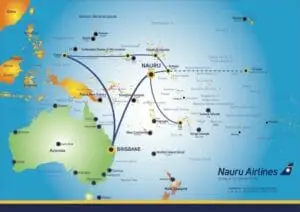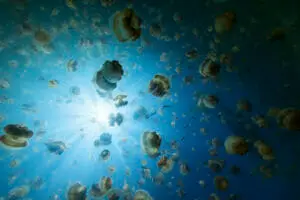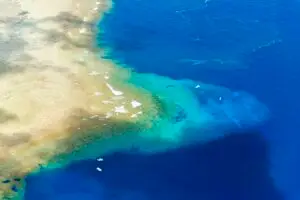Among the many things to do in Palau, few experiences compare to a visit to Jellyfish Lake.
Hidden on Eil Malk Island in the Rock Islands Southern Lagoon, this UNESCO World Heritage site is famous for allowing visitors to snorkel in calm, tropical waters surrounded by thousands of harmless jellyfish — an experience often described as “like floating in another world.”
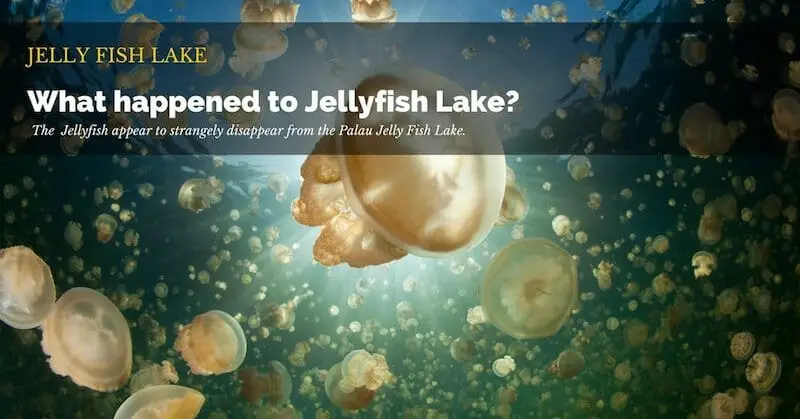
Known locally as Ongeim’l Tketau (“Fifth Lake”), Jellyfish Lake Palau is both a natural wonder and a cultural treasure. In 2025, the lake remains open, but the golden jellyfish (Mastigias papua etpisoni), once counted in the millions, have temporarily declined to just a few thousand due to recent climate patterns.
Moon jellyfish are still present in healthy numbers, and while the famous “wall of jellies” is missing this year, the lake’s tranquil setting continues to draw visitors from around the world.
What You’ll See
Moon jellyfish are still drifting in healthy numbers.
The famous “wall of jellies” is missing this year.
Yet the lake’s atmosphere, serene, magical, and deeply moving, continues to make it a must-see for many travelers to Palau.
More Than Snorkeling
For visitors, the experience is about more than just swimming among jellyfish. It’s a chance to:
Connect with Palau’s unique ecology.
Witness conservation in action.
Take part in the story of a fragile ecosystem that has rebounded before and is expected to recover again.
Setting Expectations
Jellyfish Lake can be added to your itinerary if you wish, but with the population at a historic low in 2025, many travelers choose to focus on Rock Islands highlights until the lake recovers its famous swarms.
At Palau Dive Adventures, we often pair dive days with a Rock Islands excursion combining snorkeling on shallow reefs, relaxing on quiet beaches, floating in the Milky Way’s natural mud spa, and visiting the limestone arch.
You can see how we build these experiences into our Palau dive packages.
Table of Contents
What Is Jellyfish Lake?
Jellyfish Lake in Palau, known locally as Ongeim’l Tketau (“Fifth Lake”), is one of about 70 marine lakes scattered across the Rock Islands Southern Lagoon.
What makes this one special is that it’s the only marine lake open to visitors, and it’s home to an endemic subspecies of golden jellyfish (Mastigias papua etpisoni) found nowhere else on Earth.
The lake itself is a natural phenomenon. Formed thousands of years ago when rising seas flooded ancient limestone valleys, it became a meromictic lake, meaning its layers of water don’t mix.
The upper 10–15 meters are filled with oxygen and life, while the deeper layers are dark and stagnant.
This separation creates a safe haven where jellyfish can thrive without natural predators.
Jellyfish Lake is also part of the UNESCO-listed Rock Islands Southern Lagoon, making it both a natural and cultural treasure.
For visitors, it’s more than just a place to snorkel, it’s a chance to step into a rare ecosystem that exists only here in Palau.
The Golden Jellyfish and Why They Don’t Sting
One of the most common questions visitors ask is: “Do the jellyfish in Jellyfish Lake sting?”
The answer is reassuring: not in any way you’ll feel.
The golden jellyfish of Jellyfish Lake in Palau (Mastigias papua etpisoni) are a unique subspecies that evolved in isolation for thousands of years.
With no predators in the lake, they gradually lost almost all of their stinging ability, making them safe to snorkel among, an experience found nowhere else on Earth.
Solar-Powered Survival
What makes them even more remarkable is how they live. Each jellyfish carries tiny algae called zooxanthellae inside its tissues.
The algae act like solar panels, producing sugars through photosynthesis.
The jellyfish provide the algae with a safe home in return.
A Daily Migration
To maximize sunlight for their algae, the golden jellyfish perform a daily migration across the lake:
Sunrise: they gather on the eastern side.
Midday: they drift westward with the sun.
Late morning: they often cluster in glowing groups guides call the “wall of jellyfish.”
Evening: they sink deeper, returning east to start the cycle again.
This daily rhythm is so precise that locals joke you could set your watch by it.
It’s just one example of the extraordinary marine phenomena you can encounter in Palau. Others include the famous reef hook diving at Blue Corner, where divers glide alongside sharks and schools of fish carried by strong currents.
Jellyfish Lake in 2025. What You Need to Know
If you’ve seen photos of Jellyfish Lake in Palau, you’ve probably imagined yourself surrounded by millions of golden jellyfish.
In 2025, the reality is very different.
Current Status
Golden jellyfish have declined from over 5 million to fewer than 5,600 individuals.
Moon jellyfish are still present in healthy numbers.
The famous “wall of jellies” is unlikely to appear during your visit.
The Good News
The lake is still open to visitors.
Moon jellyfish (Aurelia sp.) are present in healthy numbers.
The atmosphere of the lake, calm, otherworldly, and serene, still makes it magical.
That said, travelers should adjust expectations: the experience in 2025 is different from the postcards.
Natural Boom-and-Bust Cycle
Scientists emphasize that this decline is not unusual.
A similar crash happened during the 1998 El Niño.
Again in 2016, the jellyfish nearly vanished.
In both cases, the population rebounded within a few years once cooler, stormier weather returned.
Experts remain cautiously optimistic that the golden jellyfish will recover again.
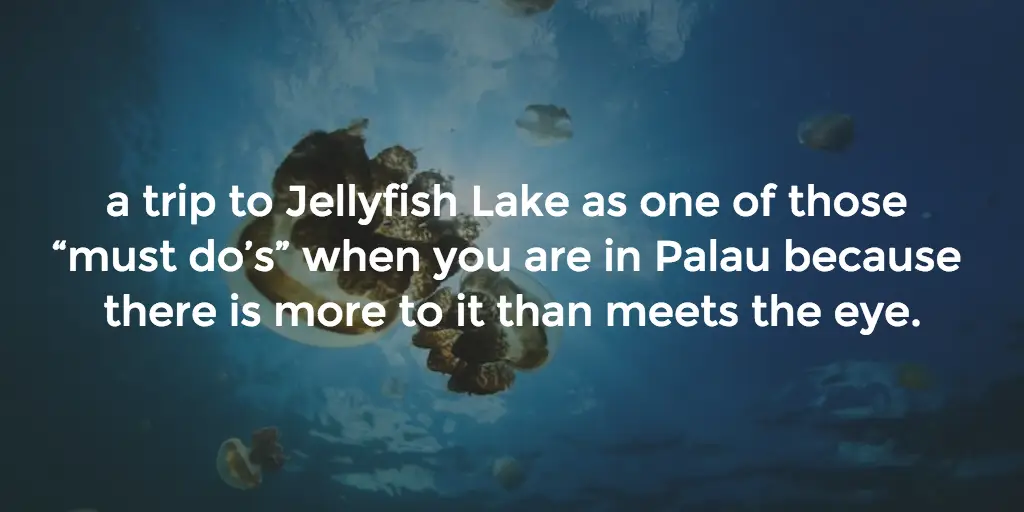
Watch Jellyfish Lake
Curious what it’s really like to swim among millions of golden jellyfish?
See the magic for yourself in our short video and get a taste of this
once-in-a-lifetime Palau experience.
Watch the Jellyfish Lake video
.
Traveler Expectations
At Palau Dive Adventures, we believe in giving guests the full picture. Jellyfish Lake is still an option, but with jellyfish numbers at a historic low in 2025, many visitors prefer to focus on the Rock Islands’ highlights, such as:
Snorkeling shallow reefs
Relaxing on quiet beaches
Floating in the Milky Way’s natural mud spa
Visiting the famous limestone arch
You can see how we include these experiences in our Palau dive packages
Permits and Rules for Visiting Jellyfish Lake
To visit Jellyfish Lake in Palau, you’ll need a special permit from Koror State.
Permits
Jellyfish Lake Permit – $100 per person (ages 6+), valid for 5 days.
Rock Islands Permit (without Jellyfish Lake) – $50 per person, valid for 10 days.
We will arrange permits in advance for our guests, but they are usually not included in tour prices. Rangers may check them during your trip, so keep yours with you.
Rules to Protect the Lake
Visiting Jellyfish Lake is a privilege, and strict rules exist to safeguard its fragile ecosystem:
Snorkeling only – Scuba diving is banned. Bubbles can harm jellyfish, and deeper layers are toxic with hydrogen sulfide.
Life vests required – For safety and to minimize disturbance to the lake.
No sunscreen (unless reef-safe) – Regular sunscreen harms jellyfish and the lake’s ecosystem.
No touching the jellyfish – Their bodies are delicate and easily injured.
Clean gear only – Snorkel gear and clothing must be rinsed in fresh water to prevent invasive species.
By following these rules, you’ll help protect one of Palau’s most unique natural wonders and support its recovery for future generations.
Best Time to Visit Jellyfish Lake Palau
Under normal conditions, Jellyfish Lake can be visited year-round. The jellyfish don’t have a fixed season, but their daily movements and Palau’s weather cycles can affect your experience.
Palau’s Seasons
Dry Season (December–April): The most popular time to visit Palau. Expect sunny skies, calmer seas, and clearer visibility. Boat rides to and through the Rock Islands are smoother, and conditions for snorkeling are ideal.
The tradeoff is higher visitor numbers, especially around holidays and spring.
The dry season (December–April) is also considered the best time for diving in Palau, especially at sites like Blue Corner and Ulong Channel. See our full guide to the best dive sites in Palau.
Wet Season (May–November): Fewer crowds and often better prices. Rain showers are common but usually brief, and tours still operate regularly.
Seas can be choppier, but the Rock Islands remain accessible and lush.
Best Time of Day
Under “normal circumstances,” The golden jellyfish perform a daily east-to-west migration across the lake, following the sun.
In healthy years, this means the mid-morning hours (around 9–11 a.m.) are the best time to see them clustered together in glowing groups.
By afternoon, they spread out across the lake. Even with fewer golden jellies in 2025, mornings are still the most scenic time to visit, with sunlight streaming into the water.

What to Expect in 2025
With fewer than 5,600 golden jellies remaining, the timing of your visit won’t significantly change how many you see.
Moon jellyfish (Aurelia sp.), however, are still abundant, and the Rock Islands scenery makes the trip rewarding regardless of jellyfish numbers.
Many of our guests at Palau Dive Adventures choose to focus on other things to do in Palau, like snorkeling shallow reefs, floating in the Milky Way’s natural mud spa, and visiting the famous limestone arch, with Jellyfish Lake as an optional stop.
What It’s Like to Swim in Jellyfish Lake
Sliding into the warm, calm water of Jellyfish Lake is an experience unlike anywhere else on Earth. At first, only a few jellyfish drift past.
As you swim further, more appear, pulsing gently in every direction. Brushing against them feels like touching a soft balloon, completely harmless and surprisingly calming.
The Experience in 2025
In healthy years, travelers described being surrounded by millions of golden jellies, often compared to “floating in outer space underwater.”
In 2025, with fewer than 5,600 golden jellies, the lake feels quieter. But moon jellyfish (Aurelia sp.) still drift in graceful numbers, and the turquoise water ringed by jungle cliffs remains magical.
The Experience
Most visits last around 30–45 minutes:
Enter from a wooden platform.
Float calmly in a life vest.
Let the silence and surreal surroundings sink in.
This isn’t an adrenaline rush it’s about wonder and stillness. A rare chance to disconnect, slow down, and feel part of one of the world’s most unusual ecosystems.
A Traveler’s Perspective
It’s less about adrenaline and more about wonder a chance to disconnect, slow down, and feel part of one of the world’s most unusual ecosystems.
Many of our guests at Palau Dive Adventures describe Jellyfish Lake as a highlight of their Rock Islands excursion. And for history lovers, Palau is also famous for dramatic WWII wreck dives, where sunken ships have become thriving reefs.
Ecology, Threats, and Conservation of Jellyfish Lake
Beneath its calm surface, Jellyfish Lake in Palau is a delicate ecosystem shaped by unique conditions.
A Fragile System
Beneath its calm surface, Jellyfish Lake is a delicate ecosystem shaped by unusual conditions. It is a meromictic lake, meaning its layers of water don’t mix:
The upper 10–15 meters hold oxygen and life.
The deeper layers are stagnant and filled with toxic hydrogen sulfide.
This separation protects the jellyfish from predators but also makes the lake highly sensitive to environmental change.
Conservation Efforts
The lake is under constant watch:
The Coral Reef Research Foundation (CRRF) conducts monthly surveys of jellyfish numbers and water quality.
Koror State Rangers enforce visitor rules on-site.
Palau has taken a global lead in marine protection by banning reef-toxic sunscreens and requiring travelers to sign the Palau Pledge, a promise to protect the environment.
Palau has also led globally in marine conservation, from these measures to the creation of the pioneering Palau Shark Sanctuary, the first of its kind in the world.
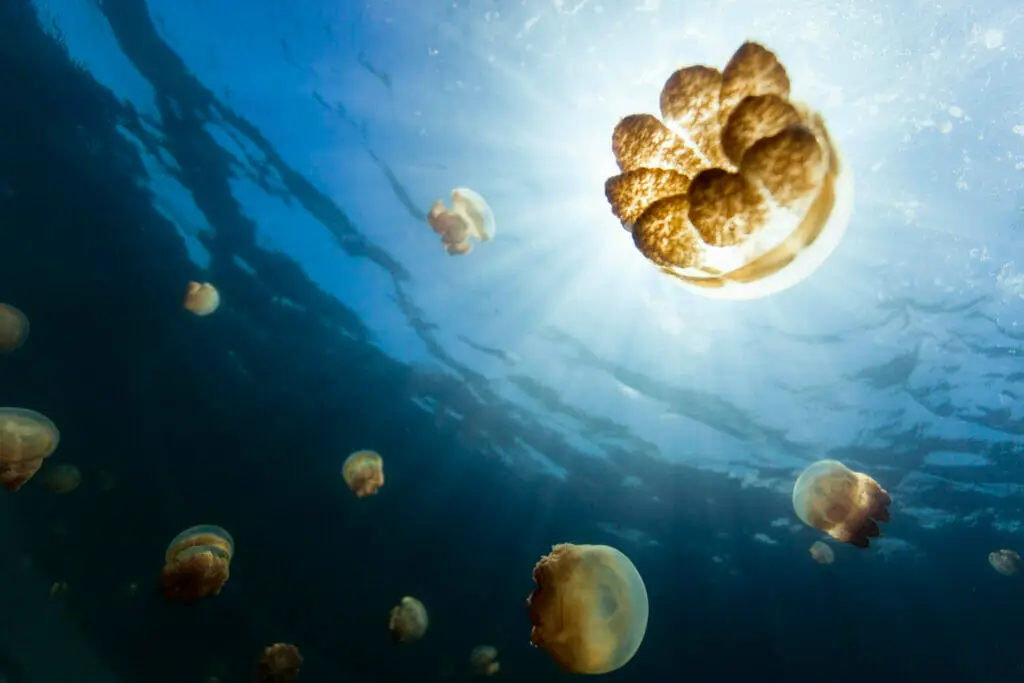
Tourism Management
Tourism is managed carefully to balance conservation and access. After the 2016 crash, the lake was closed for nearly two years to allow recovery.
While it remains open in 2025, officials are actively managing visitor expectations and ensuring rules are enforced.
A Traveler’s Role
Visiting Jellyfish Lake isn’t just about snorkeling — it’s about being part of a living conservation story. By:
Following the rules,
Moving calmly in the water, and
Supporting responsible operators,
You help protect a one-of-a-kind ecosystem that has proven it can recover if given the chance.
Travel Logistics and Tips for Visiting Jellyfish Lake
Getting There
Jellyfish Lake is located on Eil Malk Island (Mecherchar) in Palau’s Rock Islands Southern Lagoon, about 45 minutes by speedboat from Koror.
Independent visits aren’t allowed; you must join a licensed tour.
Most excursions also include Rock Islands highlights such as the Milky Way, limestone arch, and reef snorkeling.
If you’re planning your journey to the islands, our guide on how to get to Palau covers the best flight routes, airlines, and tips for arriving smoothly.
If you’re visiting from Australia, check our guide on how to get to Palau from Australia for flight options and travel tips.”
The Hike In
From the dock, expect a short but steep 10-minute jungle hike to reach the lake. The trail is rocky and uneven in places, so sturdy sandals or reef shoes are recommended. Handrails are available along some sections, but take your time especially if carrying gear.
What to Bring
Snorkel gear
Bring your own if you prefer; otherwise, your tour operator will provide it.Reef shoes or sturdy sandals
Essential for the hike and water entry.Rash guard or reef-safe sunscreen
Regular sunscreen is banned.Underwater camera/GoPro
The jellyfish are photogenic, but move slowly when filming.Dry bag & towel
There are no facilities at the lake, so you’ll leave belongings on the boat.Plenty of water
Snorkeling is tiring, and Palau’s tropical heat can dehydrate you quickly.
What to Expect
At the water’s edge, a guide or ranger will brief you on the rules (no scuba, life vests required, no touching the jellyfish, no sunscreen unless reef-safe). The water is warm (~30 °C / 86 °F), calm, and suitable for all skill levels.
Most groups spend 30–45 minutes snorkeling before continuing on their Rock Islands tour.
Even in 2025, when golden jellyfish numbers are low, the setting turquoise water surrounded by jungle remains unforgettable.

Rock Islands Excursions
At Palau Dive Adventures, we pair your dive days with full-day Rock Islands excursions. These trips combine some of Palau’s most iconic experiences, such as:
Snorkeling on shallow reefs
Relaxing on quiet beaches
Floating in the Milky Way’s natural mud spa
Visiting the famous limestone arch
Adding Jellyfish Lake
Jellyfish Lake can still be added to your itinerary in 2025. But with golden jellyfish at historic lows, many guests prefer to focus on Rock Islands highlights until the lake recovers its famous swarms.
Conclusion: A Fragile Wonder Worth Protecting
Jellyfish Lake in Palau is a rare natural gem where the gentle rhythm of golden jellyfish floating beneath sunlit water offers a level of immersion into nature that few other places can match.
2025 Reality. Still Moving
This year, golden jellyfish numbers are at a historic low, meaning the famous “wall of jellies” may not appear. Yet, the lake’s peaceful atmosphere, framed by lush jungle and glassy water, remains profoundly moving.
A Cultural Treasure, Not Just a Tourist Spot
More than just a snorkeling destination, Jellyfish Lake is part of Palau’s living heritage, tucked within the UNESCO-listed Rock Islands Southern Lagoon. Visiting is a privilege, and it carries responsibility.
Leave a Positive Legacy
Whether or not you include Jellyfish Lake in your itinerary, the Rock Islands experience is unforgettable.
By traveling responsibly, respecting lake rules, and supporting conservation, you’re helping Jellyfish Lake recover and continuing its ability to inspire future generations.
Frequently Asked Questions About Jellyfish Lake Palau
No. At least not in a way you can feel. The golden jellyfish (Mastigias papua etpisoni) evolved in isolation and lost almost all of their stinging ability. You might brush against hundreds while snorkeling, and it feels more like touching a soft balloon than being stung.
Yes. The lake remains open to visitors, but the golden jellyfish population has dropped from millions to fewer than 5,600 individuals. Moon jellies are still present in good numbers, but travelers should adjust expectations; the famous “wall of jellies” is unlikely this year.
Palau is a year-round destination. The dry season (Dec–Apr) offers the calmest seas and best weather, while the wet season (May–Nov) has fewer crowds but more rain showers. The jellyfish don’t have a strict “season,” though their numbers rise and fall naturally with climate cycles
The golden jellyfish perform a daily migration across the lake, following the sun. In healthy years, the best time to see large groups is mid-morning (9–11 a.m.), when they gather in glowing clusters. In 2025, their numbers are low, but mornings are still the most scenic time to visit
The lake is about 30 meters (100 ft) deep, but only the top 10–15 meters contain oxygen and life. Below that, the water is toxic with hydrogen sulfide, which is why scuba diving and deep free-diving are strictly prohibited.
No. Crocodiles live in Palau’s mangroves, but not in Jellyfish Lake. The lake is isolated and carefully monitored, so you can swim without worrying about large predators
Yes. As of 2025, a Jellyfish Lake permit costs $100 per person (ages 6+) and is valid for five days. This also covers entry to the Rock Islands Southern Lagoon. If you’re only touring the Rock Islands without the lake, there’s a $50 permit instead
No. All visits must be through a licensed tour operator. This ensures rules are followed and the lake is protected. At Palau Dive Adventures, we arrange permits and pair Jellyfish Lake with Rock Islands highlights like the Milky Way and limestone arch.
Most tours allow about 30–45 minutes of snorkeling inside the lake. That’s enough time to swim out to where the jellyfish gather, float among them, and take photos before continuing your Rock Islands excursion.
By rule, life jackets are mandatory, and rangers will enforce this. Some experienced swimmers may be allowed to remove them briefly, but you must still carry one with you. The rule protects both visitors and the jellyfish.
The golden jellies are harmless to people, but very fragile. Touching them can tear their bodies or rub off the protective mucous layer. If one brushes against you, just let it pass — never grab or push them.
A rash guard is the best choice for sun protection, since sunscreen is banned. Sturdy sandals or reef shoes are essential for the rocky hike to the lake. Bring a towel, dry bag, and drinking water, as there are no facilities onsite
The lake was closed from 2017 to early 2019 after the 2016 El Niño wiped out the golden jellyfish population. Officials closed it to allow the ecosystem to recover, and by late 2018 the jellies had returned in large enough numbers to reopen.
That depends on your expectations. If you’re hoping to see dense swarms of golden jellyfish, you may be disappointed. But if you value the chance to visit a unique UNESCO World Heritage site and combine it with a Rock Islands excursion, many travelers still consider it worth the trip



